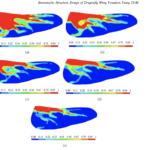Mimicking Dragonfly wings venation using topology optimization method
Dragonfly wings are mainly composed of veins and membranes, providing it special characteristics that enable the insect to be extremely versatile and maneuverable. To understand the complex venation structure of the wings, scientists have used topology optimization method (TOM) to simplify the object’s structure and created various quantitative models to mimic the dragonfly wings. More information can be found in the research paper below. Research Paper URL: https://www.researchgate.net/publication/264718458_Biomimetic_structure_design_of_dragonfly_wing_venation_using_topology_optimization_method
Learn about our two Decals!
 Click here to find out more about our Fall Bioinspired Design Decal and our Spring Bioinspired Design in Action Decal – ALL MAJORS are welcome.
Click here to find out more about our Fall Bioinspired Design Decal and our Spring Bioinspired Design in Action Decal – ALL MAJORS are welcome.Berkeley BioDesign Community
 Click here to learn about the BioD: Bio-Inspired Design @ Berkeley student organization or here to signup for more info.
Click here to learn about the BioD: Bio-Inspired Design @ Berkeley student organization or here to signup for more info.Search
Student Login




I imagine that the neurological circuits underlying these processes are governed by both 2d spacing maps with their brains as…
to reduce the impact of car accidents, it may be possible to study the force diverting physics of cockroaches to…
you see this type of head-bobbing stability in many avian creatures related to pigeons like chickens. the head ability to…
not like they taught horses how to run! this is an example of convergent evolution where both sea creatures and…
The brain functions in a similar way with neuronal connections. our brains are able to utilize the multiplicity of connections…